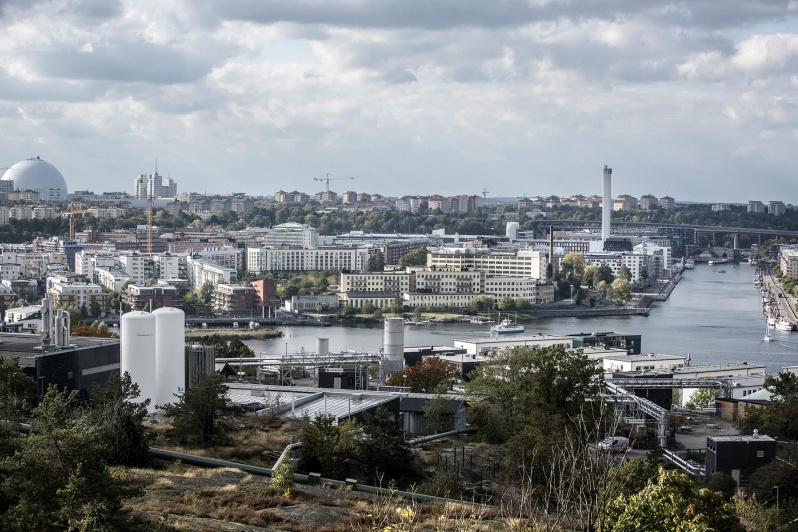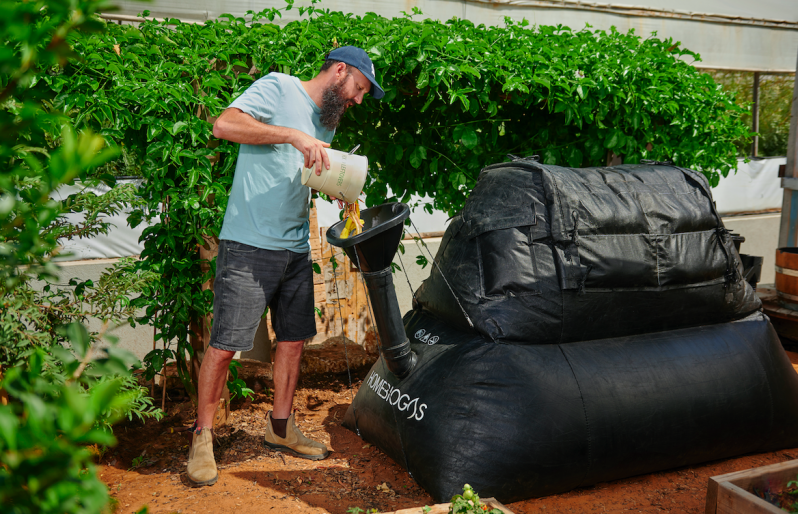Examples of biogas production
1.Magic Factory, Tönsberg, Norway
1.Magic Factory, Tönsberg, Norway
Heaven on earth
To recreate ecological systems in space, the European Space Administration has analyzed every biochemical step required. The results are described as "The Melissa Loop".
Based on this, biologist Ketil Stoknes and his team has created something truly miraculous and climate clever at a biogas production plant in Tönsberg, one hour south of Norwegian capital Oslo.
Like greenhouses not using glass but has walls built from two sheets of plastic film containing a 30 cm thick layer of soap bubble foam. The foam being produced by soap bubble machines invented and marketed by spin-off "The Bubble Company".
Or "digeponics", Ketil´s own invention to let the roots systems of tomato plants soak in a nutrient rich fluid coming out of the biogas chamber next door.
Or like using nano technology to increase root uptake of green carbon dioxide from the same biogas process.
Or combining all this in a way to cultivate tomatoes with 98% reduction in climate impact compared to conventional European tomato production.
Or making every building and vehicle involved like digesters, garbage trucks and local buses part of an art project, painting them to look good, draw attention, raise curiosity and make people happy.
Sound like a fantasy?
Welcome to the Magic Factory - the Tomorrowland of biogas production and greenhouse farming.
Images: Joakim Ståhl/Biogas Academy
World #1 fueling station design
Målilla, Sweden
Målilla, Sweden
A global example for all farms
Tom Birgersson is oldest of three in the second generation at Hagelsrums Gård (Sw: gård = Eng: farm) in Målilla, Sweden. After studying to be a civil engineer in chemical biology at Linköping University, Tom leads a development the entire family, his father Åke as well as brother Jakob and sister Hanna have all agreed upon.
With economic support from Klimatklivet, ( "Climate Leap". State financed program) Hagelsrums Gård has invested in a facility that treats cow manure from five farms After three weeks in the digester two products are available:
- liquid ecofertilizer
- biogas suitable for heating homes or generating electricity. Or to be "upgraded" to biomethane and used as vehicle fuel, see below.
This model is applicable at every farm regardless of size in the world.
From Hagelsrum the resulting fertilizer is trucked back to the farms and used to enrich the soil. Reducing the need to use imported chemical fertilizer.
The biogas is purified to vehicle fuel quality and sold at some of the five fueling stations the family has designed and built in nearby towns Eksjö, Högsby, Vimmerby, Hultsfred and Målilla.
Calculations by Professor Pål Börjesson, Lund Institute of Technology shows that running a car on biomethane from Hagelsrum reduces climate impact by a whopping 128!!
Not surprisingly, Tom´s eco-designed fueling stations are probably the classiest in the world.
Images: Joakim Ståhl/Biogasacademy/SvDDu
Swedish secrets in the dark

Securing fuel supply and clever urban recycling - a no-brainer for every modern city
In the darkness of the Henriksdal sewage treatment facility in Stockholm City a kindered kind of magic is taking place. Similar to the possibility of producing biogas from manure from cows and pigs, this can also be done with what we humans flush down the toilet.
The biogas produced at Stockholms sewage treatment facilities is concentrated to biomethane and used to fuel low emission city buses. The model is used in many Swedish cities. According to our research, it was a study programme arranged for a delegation of Californian engineers and policymakers in 2007 that sparked the idea of bringing biogas technology to Californa. Seeing is believing (Click here to see our 27 minute film about this and and so much more)
The bus depot at Fredriksdal
What even fewer Stockholmians are aware of is that since 2017, biomethane from Henriksdals sewage treatment facility is pipelined 2 kilometers to nearby Fredriksdal right next to the Skanstull bridge where a subterrainean bus depot houses 140 biomethane buses. Very clever and very slick.
Biogas providing for refugees

Three billion people in the world cook over open fires. This means having to spend time finding wood (or worse: plastics) to burn, sometimes having to spend money buying it. It means trees being cut down instead of providing shade and protecting fertile soil from being washed away by heavy rain.
Simultaneously, millions of people die every year from "indoor air pollution" ( meaning they inhale the fumes from stoves). The same populations are hit hard by infectious diseases caused by poor water quality and lack of solid waste collection..
HOMEBIOGAS solves these problems. Instead of leaving animal droppings in the ground they go into the system shown in the image. Together with kitchen waste like peels, leftovers and coffee grinds.
Out of the HomeBiogas unit comes biogas enough to fuel a cooking stove two ours/day. Added to this, a high nutrient, liquid fertilizer is the second product of the process.
- Saving money spent on firewood
- saving time from fetching wood
- no need to cut trees for fuel
- reducing infectious diseases and sickness from breathing air polluted by smoke.



















